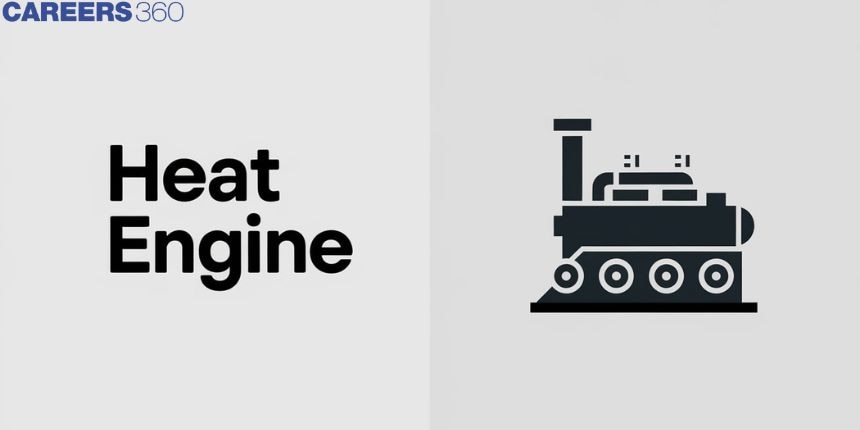Heat Engine
A heat engine is a device that converts thermal energy into mechanical work, commonly seen in car engines and power plants. This conversion is fundamental to much of our modern technology, making understanding how heat engines work crucial for students preparing for board exams and competitive exams like JEE and NEET. This article explains the basic principles of a heat engine in simple terms. It includes a solved example to demonstrate the process, helping you see how theoretical concepts are applied to create useful mechanical energy from heat.
This Story also Contains
- What is a Heat Engine?
- Solved Examples Based on Heat Engine
- Summary

What is a Heat Engine?
A heat engine is a device that converts heat into work continuously through a cyclic process.
The essential parts of a heat engine are
1. Source: It is a reservoir of heat at high temperatures and infinite thermal capacity. Any amount of heat can be extracted from it.
2. Working substance: Steam, petrol, etc.
3. Sink: It is a reservoir of heat at low temperatures and infinite thermal capacity. Any amount of heat can be given to the sink.
Working on heat Engine

As shown in the above figure, The working substance absorbs heat Q1 from the source, does an amount of work W returns the remaining amount of heat (i.e Q2) to the sink and comes back to its original state and there occurs no change in its internal energy.
To obtain work continuously, the same cycle is repeated over and over again.
The efficiency of the heat engine ($\eta$)- It is defined as the ratio of useful work obtained from the engine to the heat supplied to it. The performance of the heat engine is expressed by means of “efficiency”.
$
\text { I.e } \eta=\frac{\text { Work done }}{\text { Heat input }}=\frac{W}{Q_1}
$
For a cyclic process $\Delta U=0$
so From the first law of thermodynamics,
$
\begin{aligned}
& \therefore \Delta Q=\Delta W \quad \text { so } \quad W=Q_1-Q_2 \\
& \quad \eta=\frac{Q_1-Q_2}{Q_1}=1-\frac{Q_2}{Q_1}
\end{aligned}
$
Practically, the efficiency of an engine is always less than 1.
Recommended Topic Video
Solved Examples Based on Heat Engine
Example 1: An ideal heat engine exhausting heat at $77^{\circ} \mathrm{C}$ is to have a $30 \%$ efficiency. It must take the heat at (in ${ }^{\circ} C$ )
1) 227
2) 500
3) 327
4) 600
Solution:
The efficiency of the heat engine $(\eta)$
$
\eta=\frac{Q_1-Q_2}{Q_1}=1-\frac{Q_2}{Q_1}
$
We know the heat transferred to the system $\Delta Q=m C \Delta T$
$
\begin{aligned}
& \text { so } \Delta Q \propto \Delta T \\
& \eta=1-\frac{T_2}{T_1} \Rightarrow \frac{30}{100}=1-\frac{350}{T_1} \\
& \frac{350}{T_1}=1-\frac{30}{100}=\frac{70}{100}=\frac{7}{10} \\
& T_1=500 \mathrm{~K}=227^{\circ} \mathrm{C}
\end{aligned}
$
Hence, the answer is option (1).
Example 2: An ideal heat engine working between temperatures $T_1$ and $T_2$ has an efficiency $\eta$, the new efficiency if both the source and sink temperature are doubled, will be:
1) $\frac{\eta}{2}$
2) $\eta$
3) $2 \eta$
4) $1.5 \eta$
Solution:
The efficiency of the heat engine ( ${ }^\eta$ )
$
\eta=\frac{Q_1-Q_2}{Q_1}
$
We know the heat transferred to the system $\Delta Q=m C \Delta T$
$
\begin{aligned}
& \text { so } \Delta Q \propto \Delta T \\
& \eta=\frac{T_1-T_2}{T_1}
\end{aligned}
$
If both the source and sink temperature is doubled; $T_1^{\prime}=2 T_1$ and $T_2^{\prime}=2 T_2$
$
\begin{aligned}
\eta^{\prime} & =\frac{T_1^{\prime}-T_2}{T_1^{\prime}} \\
\eta^{\prime} & =\frac{2 T_1-2 T_2}{2 T_1}=\frac{T_1-T_2}{T_1}=\eta
\end{aligned}
$
Hence, the correct option is 2.
Example 3: A reversible heat engine converts one-fourth of the heat input into work. When the temperature of the sink is reduced by 52 K, its efficiency is doubled. The temperature in Kelvin of the source will be _________.
1) 108 K
2) 208 K
3) 308 K
4) 408 K
Solution:
Initially $\eta=\frac{1}{4}=1-\frac{T_2}{T_1}$
$
\Rightarrow \frac{T_2}{T_1}=\frac{3}{4} \ldots (1)
$
When the temperature of the sink is reduced by 52 K then
$
\Rightarrow \frac{T_2-52}{T_1}=\frac{1}{2} \ldots \text { (2) }
$
$
\begin{aligned}
& \text { Using equation (1) } \\
& \frac{T_2}{T_1}-\frac{52}{T_1}=\frac{1}{2} \\
& \frac{3}{4}-\frac{52}{T_1}=\frac{1}{2} \\
& \Rightarrow T=208 \mathrm{~K}
\end{aligned}
$
Hence, the answer is option (2).
Summary
Heat engines are mechanisms that convert thermal energy into mechanical work. They function by conducting heat from a high-temperature body to a low-temperature one, losing a part of the heat as they work in the process. Some popular examples include car engines and steam turbines. In most cases, these machines cyclically absorb heat, perform work and throw off waste heat. The performance of such an engine usually depends on how hot its source is compared to its sink; greater distances normally offer increased efficiencies.